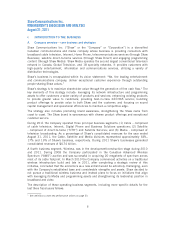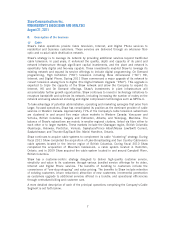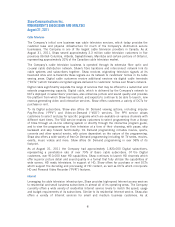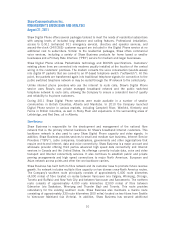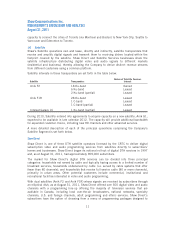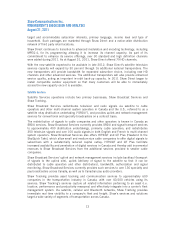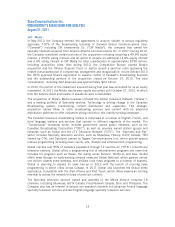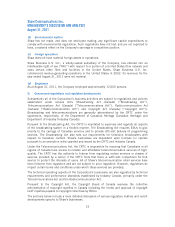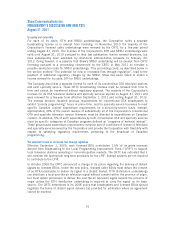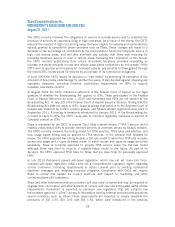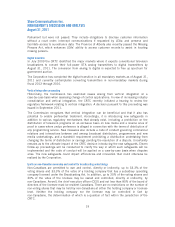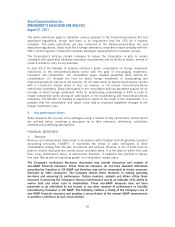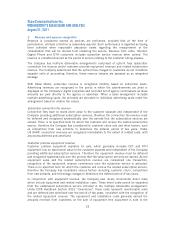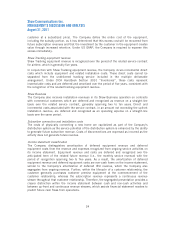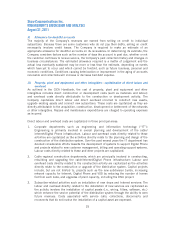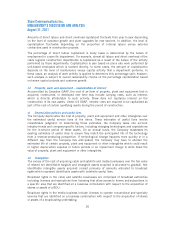Shaw 2011 Annual Report Download - page 20
Download and view the complete annual report
Please find page 20 of the 2011 Shaw annual report below. You can navigate through the pages in the report by either clicking on the pages listed below, or by using the keyword search tool below to find specific information within the annual report.Shaw Communications Inc.
MANAGEMENT’S DISCUSSION AND ANALYSIS
August 31, 2011
Licensing and ownership
For each of its cable, DTH and SRDU undertakings, the Corporation holds a separate
broadcasting license or is exempt from licensing. In November 2010 the majority of the
Corporation’s licensed cable undertakings were renewed by the CRTC for a five-year period
ending August 31, 2015. The licenses of the Corporation’s DTH and SRDU undertakings were
valid until August 31, 2010 pursuant to their last substantive licence renewal decisions, but
have subsequently been extended, by short-term administrative renewals, to February 29,
2012. Going forward, it is possible that Shaw’s SRDU undertaking will be exempt from CRTC
licensing pursuant to a proceeding commenced by the CRTC in May 2011 to consider a
possible exemption order for SRDU undertakings. This proceeding could, as described below in
the section entitled “The potential for new or increased fees through regulation”, lead to the
payment of additional regulatory charges by the SRDU. Shaw has never failed to obtain a
license renewal for its cable, DTH or SRDU undertakings.
The Company also holds a separate license for each of its conventional OTA television stations
and each specialty service. These CRTC broadcasting licenses must be renewed from time to
time and cannot be transferred without regulatory approval. The majority of the Corporation’s
licenses for its OTA television stations and specialty services expired on August 31, 2011 and
were renewed for a five-year term effective September 1, 2011 and ending August 31, 2016.
The renewal decision replaced previous requirements for conventional OTA broadcasters to
exhibit “priority programming” hours in prime time, and for specialty service licensees to meet
specific Canadian content expenditure requirements on a service-by-service basis. Instead,
approximately 30% of the overall revenue of substantially all of the Corporation’s conventional
OTA and specialty television service licensees must be directed to expenditures on Canadian
content. In addition, 5% of such expenditures by both conventional OTA and specialty services
must be specific categories of Canadian programs defined as “programs of national interest”.
These group-based expenditure requirements comprise part of conditions of license of television
and specialty services owned by the Corporation and provide the Corporation with flexibility with
respect to satisfying regulatory requirements pertaining to the broadcast of Canadian
programming.
The potential for new or increased fees through regulation
Effective September 1, 2009, each licensed BDU contributes 1.5% of its gross revenues
derived from Broadcasting to the Local Programming Improvement Fund (“LPIF”) to support
local television stations operating in non-metropolitan markets. The CRTC has indicated that it
will consider the appropriate long-term provisions for the LPIF. Exempt systems are not required
to contribute to the LPIF.
In October 2008 the CRTC announced a change in its policy regarding the delivery of distant
signals by licensed BDUs. Under the new policy, licensed cable BDUs must obtain the consent
of an OTA broadcaster to deliver its signal in a distant market. DTH distribution undertakings
can distribute a local over-the-air television signal without consent within the province of origin,
but must obtain permission to deliver the over-the-air television signal beyond the province of
origin unless the DTH distribution undertaking is required to carry the signal on its basic
service. The CRTC determined in its 2008 policy that broadcasters and licensed BDUs should
negotiate the terms of distant signal delivery but provided for arbitration where an agreement
cannot be reached.
16


